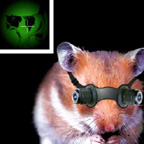October 28, 2005
PLAN: Mikel Maron

Locative Animals
Mikel Maron’s presentation of his contribution for the Open Plan workshop is very insightful and original. I like his ‘locative animal‘ concept very much:
"My [Mikel Maron] angle in my application to the Workshop was Locative Animals. Nothing much happened on this, but I did get to meet a researcher with similar interests, Shaun Lawson. Here’s the blurb I submitted on Locative Animals.
My interest in Locative Arts has been somewhat on the fringes of the predominantly urban, socially focused arts projects. The natural world is under ever greater stresses, and these technologies, usually employed to buffer nature, can and have been effectively used to raise awareness of the non-human world and give it a voice. The idea of over saturation of technology has been parodied by projects like "Augmented Animals," though in reality new communication modes are being employed by wildlife researchers to track elephants and reindeer by SMS and GPS. I’ve been gathering various resources on spatial technology and spatial understanding in animals under the moniker Locative Animals.
Nature is not separate from urban experience, though most city dwellers would not be that aware of the populations living in their midst. Sensing and tracking of wild fuana and flora in urban environments could raise awareness of wildlife in a tangible, positive way. Bird watchers are particularly active and independent; tools to bridge individual bird monitoring into larger situated databases and patterns could be another interesting application of the technology. Another interesting area is Porton Downs, site of much controversial chemical testing, but due to the lack of intensive human activity, also home to many rare species that have disappeared from the rest of the UK. If access is be attained, artistic investigations of nature on this site would be potentially very insightful.
This concept grows out of my interest in spatial models of ecosystems, and spatial niches. Birds may not be able to navigate human buildings that competently, but they can migrate to precise locations over 1000s of miles, with senses evolved for the purpose. In other words, a map is only one (and sometimes inferior) way to get around. The Nottingham Jubilee Campus was a pretty successful brownfield restoration, melding natural and urban fabric." [blogged by Nicolas on pasta and vinegar]
Posted by jo at October 28, 2005 09:24 AM
